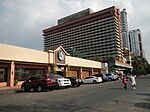Adriatico Street

Adriatico Street is a north–south road connecting Ermita and Malate districts in Manila, Philippines. Its northern terminus is at Padre Faura Street in Ermita carrying southbound traffic all the way to Quirino Avenue in Malate. South of Quirino, the street becomes two way with a wide median running down the center from just past the Manila Zoo up to its southern terminus at Ocampo Street. Adriatico is known primarily for its restaurants and bars centered on the area around Manila's Korea Town between Pedro Gil and San Andres Streets, considered the center of bohemian night life in the city.The street was named in 1964 after Macario Adriatico, a Filipino parliamentarian and author of Manila's city charter. It was formerly known as Dakota Avenue, after the U.S. states of North and South Dakota, collectively known as The Dakotas.
Excerpt from the Wikipedia article Adriatico Street (License: CC BY-SA 3.0, Authors, Images).Adriatico Street
San Andres Street, Manila Malate (Fifth District)
Geographical coordinates (GPS) Address Nearby Places Show on map
Geographical coordinates (GPS)
| Latitude | Longitude |
|---|---|
| N 14.568888888889 ° | E 120.98666666667 ° |
Address
San Andres Street 558
1004 Manila, Malate (Fifth District)
Philippines
Open on Google Maps








